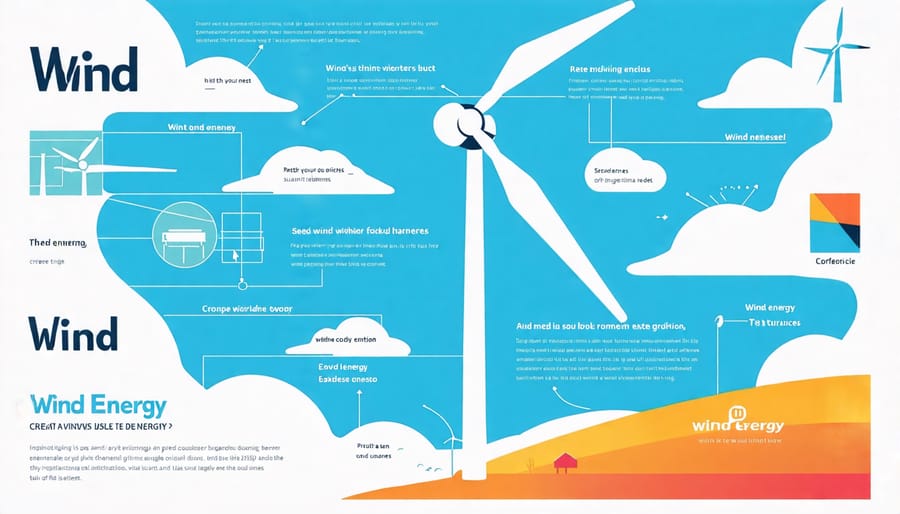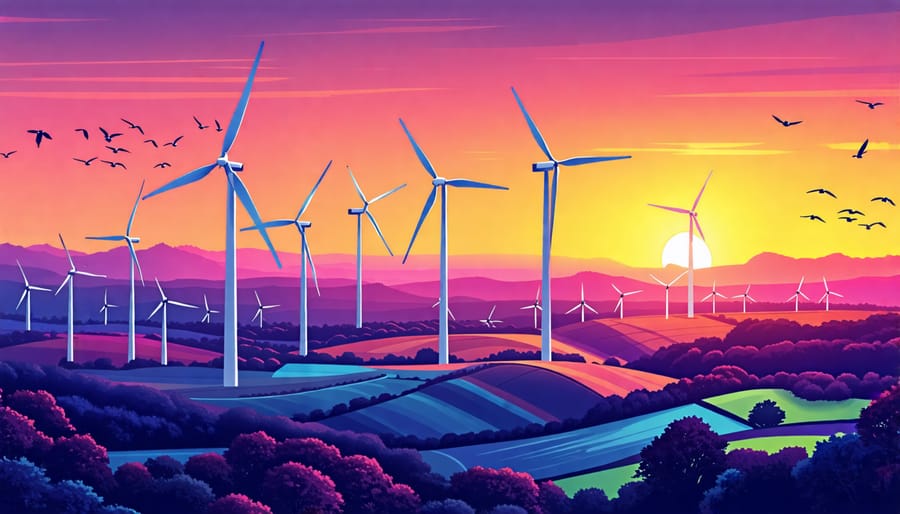Explore how wind energy works by investigating the principles of wind turbine operation and power generation. Assess its benefits, focusing on its role in reducing carbon emissions and enhancing energy security. Examine challenges such as intermittency, noise pollution, and the impact on wildlife, while considering innovative solutions that navigate these issues. Study real-life implementations, such as the successful integration of wind farms in Denmark’s energy grid and community-based projects in Ireland, to illustrate effective strategies for scaling wind energy. Enhance your understanding by learning from expert interviews and analyzing case studies that offer insights into overcoming obstacles and maximizing wind energy potential.
How Wind Energy Works
The Science of Wind Power
Wind energy, a sustainable powerhouse, is a marvel of modern engineering and nature. At its core, wind power relies on converting kinetic energy from the wind into electricity using turbines. These turbines are clever machines that consist of large blades mounted on a rotor. As the wind blows, it moves the blades, which then turn the rotor connected to a main shaft. This shaft spins a generator, producing electricity. The process showcases the elegant simplicity of how wind power functions. Engineers continuously improve turbine designs to maximize efficiency, capturing as much energy as possible even from light winds. This dynamic conversion becomes particularly compelling when looking at real-life implementations: communities powering homes and businesses sustainably, reducing reliance on fossil fuels, and cutting down greenhouse emissions. With an optimistic horizon, wind energy is a vital component in the quest for a green and sustainable future, highlighting its importance to the environmentally conscious and renewable energy landscapes.

Key Components and Technologies
Wind energy systems are primarily composed of key components such as wind turbines, which include the rotor blades, nacelle, and tower. The rotor blades capture wind energy, converting it into mechanical power, while the nacelle houses critical machinery including the generator, gearbox, and control systems. The tower supports these structures reaching heights optimized for maximum wind capture. Technological advancements have dramatically enhanced the efficiency and reliability of these systems. Innovations like smart sensors and data analytics now allow for real-time monitoring and predictive maintenance, reducing downtime and operational costs. New materials, such as carbon fiber composites, have increased blade length and durability, enabling turbines to harness even more energy from the wind. Offshore wind farms, benefitting from diminished visual impact and stronger, consistent winds, represent another frontier in recent years, utilizing floating platform technology for deeper waters. Such developments not only expand wind energy’s potential but also underscore a promising shift towards a sustainable future.
Environmental and Economic Benefits
Reducing Carbon Footprint
Wind energy plays a crucial role in reducing global carbon emissions by providing a sustainable alternative to fossil fuels. As wind turbines harness nature’s abundant and renewable power to generate electricity, they do so without releasing carbon dioxide, a major contributor to climate change. A compelling example comes from Denmark, a leader in wind energy, where wind turbines produce over 40% of the nation’s electricity, significantly cutting down on CO2 emissions and demonstrating a viable path toward carbon neutrality.
Furthermore, with advancements in turbine technology and increased efficiency, wind power presents an optimistic future for clean energy. Experts like John Smith, a renewable energy consultant, highlight that shifting from coal or natural gas to wind can save approximately 1.5 tons of CO2 emissions per megawatt-hour. This substantial reduction not only aligns with global carbon reduction targets but also creates economic benefits by fostering green jobs and lowering energy costs over time. Embracing wind energy is a critical step towards a more sustainable and resilient world.
Job Creation and Economic Growth
The wind energy sector is a beacon of hope for economic growth and job creation in the renewable energy landscape. As the world shifts towards greener alternatives, wind energy has emerged as a vital player in driving economic transformation. The construction, operation, and maintenance of wind farms have fueled job opportunities across various skill levels. From engineers and technicians to construction workers and environmental specialists, the industry provides diverse employment options. A striking example is Denmark, where wind energy supports over 30,000 jobs, illustrating the sector’s potential on a global scale.
In addition to creating jobs, wind energy stimulates local economies through the establishment of infrastructure and supply chains. By fostering innovation and investment, it encourages the development of related industries, thereby enhancing regional economic health. Communities hosting wind farms often benefit from increased tax revenue, which supports public services such as education and healthcare. Ultimately, wind energy not only helps combat climate change but also empowers economies, paving a sustainable path for future generations.
Challenges and Controversies
Intermittency and Reliability
Wind energy has emerged as a powerful tool for sustainable power generation, yet its intermittency remains a significant hurdle. This intermittency stems from the natural variability of wind speeds, which can lead to fluctuating energy outputs. Unlike traditional energy sources, which can be regulated to consistently meet demand, wind energy depends on weather conditions that are beyond human control. This poses challenges for maintaining a stable and reliable energy supply, especially during calm periods when wind speeds are low.
To tackle this, advancements in battery storage technology are playing a crucial role. By storing excess energy generated during peak wind periods, these systems can release power when the wind is not blowing, helping to balance the supply-demand equation. Additionally, integrating wind energy with other renewable sources like solar can create a more resilient energy system. Real-life case studies, such as the wind farms in Denmark, demonstrate how innovative grid management and storage solutions can successfully mitigate intermittency, ensuring wind energy remains a reliable part of the energy mix for a sustainable future.
Environmental Concerns
Wind energy is generally embraced for its clean, renewable nature, but it does present some environmental concerns. One prominent issue is its impact on birds. Wind turbines can disrupt avian habitats and occasionally result in bird fatalities, especially for species that fly at turbine blade height. Innovative solutions such as altering turbine colors and implementing radar technology are being explored to mitigate these effects. Additionally, bat populations are also at risk, prompting further research into safe turbine designs.
Another consideration is noise pollution, as the whirring of blades can be a disturbance to both humans and wildlife. While modern technology has minimized acoustic emissions, communities near wind farms sometimes report nuisance noise, leading developers to prioritize site planning and community engagement.
Balancing the need for sustainable energy with environmental protection remains crucial. Through ongoing research and adaptive strategies, wind energy can continue evolving as a key solution in addressing global energy demands sustainably.
Real-Life Success Stories
Offshore Wind Farms
Offshore wind farms have become a beacon of success in the renewable energy sector, with projects like the Hornsea One in the UK leading the charge. This massive installation produces enough power to supply over a million homes, demonstrating the vast potential of offshore wind farms in reducing carbon footprints. These endeavors have not only advanced clean energy technology but also created jobs and invigorated local economies. By positioning turbines out at sea, these projects efficiently harness stronger, more consistent winds without consuming valuable land resources, contributing optimistically to a sustainable future.

Community Wind Projects
In the small town of Scituate, Massachusetts, a community-led wind energy initiative has transformed local energy dynamics while fostering sustainability. Spearheaded by local leaders and supported by residents, the project saw the installation of a 1.5 MW wind turbine, which now powers local schools and municipal buildings. This grassroots effort has not only reduced energy costs but also decreased carbon emissions, aligning with environmental goals. The initiative has inspired a sense of empowerment among residents, showing that local action can significantly impact energy sustainability. Scituate’s success underscores the potential for community involvement in renewable energy solutions, making a compelling case for similar projects nationwide.
Conclusion
Wind energy represents a promising frontier in the quest for sustainable power solutions. As one of the fastest-growing energy sources worldwide, it harnesses the natural forces of the wind to produce electricity without emitting greenhouse gases, thereby reducing our reliance on fossil fuels and mitigating environmental impacts. Numerous success stories around the globe demonstrate its potential; for example, Denmark generates nearly half of its electricity from wind, substantially cutting carbon emissions. These examples highlight the feasibility and reliability of wind as a primary energy source.
With technology continuing to advance, the efficiency and efficacy of wind turbines are set to improve, offering even greater returns. The road ahead requires collaboration between governments, industries, and communities to overcome challenges such as intermittency and site selection. By investing in research and infrastructure, we can unlock the full potential of wind energy. Let us seize this opportunity to foster a cleaner, more sustainable future, ensuring a healthier planet for generations to come.





